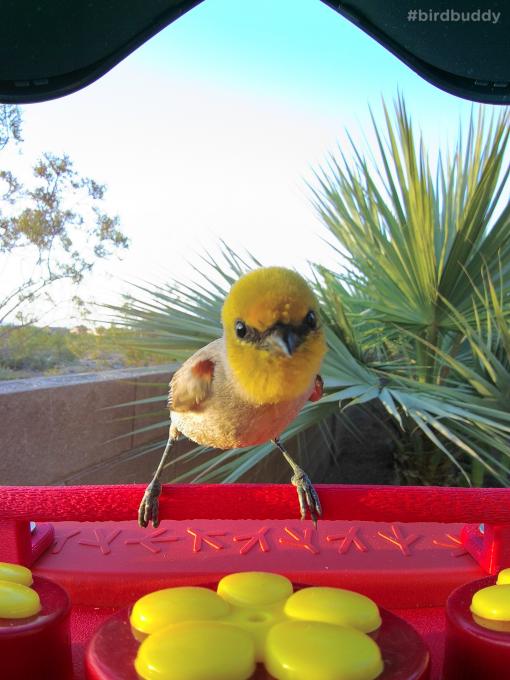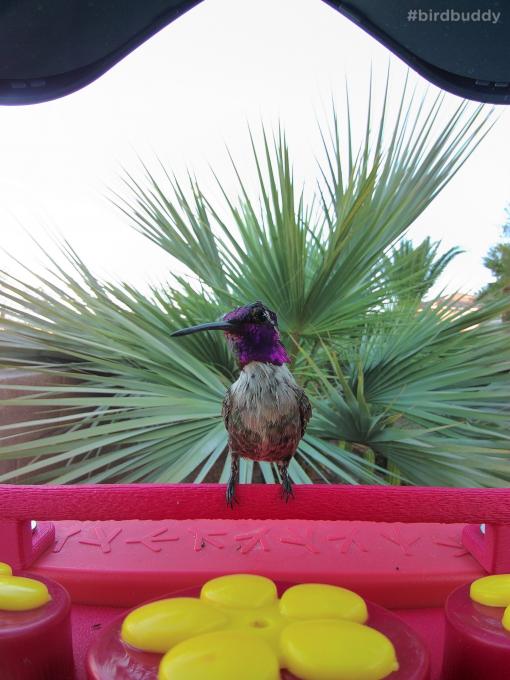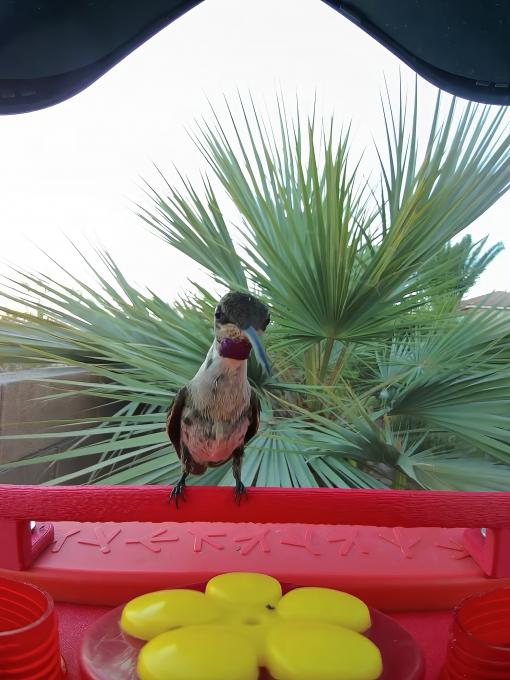The Cornell Lab Bird Academy › Discussion Groups › The Wonderful World of Hummingbirds › Life of a Hummingbird
-
It seems that many aspects of a hummingbird's life are similar to other species of birds - courtship, nest building, caring for young, migrating. After reading about how hummingbirds enter a state of torpor at night, I'm wondering how this works when the female is incubating eggs? Does her body trap heat close to the eggs to keep them warm while she sleeps?
-
Most of the most common (visible) birds in the southeastern US are songbirds who either do not migrate, or that do, but because they come from farther north, as well as being local, like Robins, are almost always around, whether living here, or passing through on their way both south and north. Most of such birds that live in conjunction to humans raise several clutches of chicks per breeding season, and both parents are equally involved in caring for them. It is comical to see the fledged and nearly grown chicks, often as large as their parents, trying to extend their "childhood" by badgering their parents to keep feeding them, as the parents try to "kick them out of the nest," as is often said about human parents.
-
Hummingbirds have a very intense migration, with some crossing the entire Gulf of Mexico in a day of flight. I can't think of any other birds that migrate so far compared with their body length, when you put into perspective how small they are and how far they fly, the Hummingbird is truly an amazing set of birds! In my area, Anna's Hummingbirds can be spotted, or heard, year round. I look forward to further investigating them in all seasons!
-
The migration of birds is a interesting story, whether it focuses on the origin of migratory behavior or the ability of these animals to get to their destination. The fact that tiny birds like the hummingbirds are not just aerial acrobats and really fast flyers but are also long-distance champions is just mind-blowing.
-
I notice that certain birds that come to my feeder readily fly away if challenged by other birds, larger or even smaller. The hummingbirds as this course shows, are not easily challenged and will "fight" for the right to feed. All birds protect their young and feed them for varying lengths of time. Different species of hummers build different kinds of nests so do other birds. As with other birds some hummers migrate others are resident in the area where they were born.......Central America being the most usual areas. Question.."Do we know anything about the lifespan of a hummer?
-
I added a seed feeder to our backyard and the hummingbirds were disturbed, especially by the House Sparrows. I converted the BirdBuddy from seed with an after-marker nectar. The first visitor was a bit confused ...
 It took a few weeks for the hummingbirds to return. There is still a territorial male but from time to time the BirdBuddy AI recognizes a member of the Hummingbird family:
It took a few weeks for the hummingbirds to return. There is still a territorial male but from time to time the BirdBuddy AI recognizes a member of the Hummingbird family: BirdBuddy's Hummingbird feeder may be a year away and the AI needs more training. Even Merlin Bird ID missed this
BirdBuddy's Hummingbird feeder may be a year away and the AI needs more training. Even Merlin Bird ID missed this

-
What is the first pic of?
-
-
It is fascinatng that males and females in some species of birds share the responsibility of raising the young, but not hummingbirds. They seem more terratorial than most other birds. The expandable nests are cool!
-
I agree that the expanding nests are cool! It makes sense; however, didn’t think about it before.
-
The expansion does make sense! Those guys are adult size before fledging and look like they shouldn't fit.
-
-
I learned here that hummingbirds migrate during the day and can go into turpor at night. I learned from other resources of the Cornell Lab of Ornithology that other birds migrating north to the US in the spring fly at night, (and that is why man-made light can be disorientating)
-
The biggest difference is their independence & territorialism. My other avian visitors take turns (mostly) at the feeders but these little buggers can't seem to do it! The only time I have more than one at a feeder is the newly fledged till they realize they shouldn't be sharing! There are lots of raptors in the area which may be seen out alone but I know they go back to their mates and young ones. I can't think of any similarities besides drinking the same sugar water as the Bullock's Orioles.
-
I have hummingbird feeders out and other bird feeders out. I will have the American Goldfinch as an example of another bird. I noticed that both species can get a little territorial with their food as both species are out there to survive and produce. The obvious difference is the food intake. Hummingbirds like to have mostly nectar since that is 90% of their diet and only 10% of it is insects. The American Goldfinch for example eats neither of those and they are granivores that eat mostly seeds from trees and annual plants.
-
I was surprised that the male has no part in the nest prep or rearing of the young- so unlike the Red Tail Hawks. Mating dances are much more elaborate than other birds. I didn't know they also ate insects.
-
I had learned about them eating insects when I saw them feeding on bugs over a river in Evergreen CO. It initially surprised me and it was great to get confirmation that I wasn’t loosing my mind 😊
-
-
My observation of hummingbirds in Tucson is primarily with Anna's. They probably display more territoriality than any other birds I see in the this area. Sometimes they can be very aggressive especially to other Anna's.
-
No Rufus around you? I get them on their fall migration for a couple weeks and can't wait for them to leave. Talk about aggression, it's hard to believe they would let any close enough to even mate!
-
@Donita I agree! I live in St. Louis Missouri and normally we have only Ruby-throats. Rarely we get a stray Rufous in the fall and I have had them in my yard. One October, I stepped out into the backyard and heard a kind of a "SMACK" sound. I thought it might be the chip of a Junco, but it was a Rufous. He took over the Mexican Sage (Salvia leucantha) which had just started to bloom. He stayed several days and I watched him chase away Robins, Cardinals, and Mourning Doves. Once he chased a Blue Jay down the block!
-
-
One of the biggest differences is the males do not participate in nest building and caring for the young birds. Their body structures also allow them to fly in all directions. They are the true acrobats of the bird kingdom.
-
After all that dancing and display to get the females attention and favoring him for mating he leaves and does not participate on rising the chicks? Well at least she incubate her own eggs and do not also leave them like the cowbirds where neither parent are involved in rising the chicks.
-
I do notice some birds being a little aggressive at our feeders especially the red-bellied woodpeckers with their sharp beaks. Even some of the Mourning Doves are! Hummingbird males are something else! Fancy dancers! I don’t know how the females do it. I guess they must have to leave the chicks to go find food. I thought the expandable nests were cool too! So amazing! I will have to checkout the Woodcocks!
-
Expandable nests, how cool is that! Only 2 eggs. Courtship displays are so elaborate & expend so much energy with repetitions. After all that work, they maybe mate & then they’re done! No further involvement. Altitude migration of Hillstar & torporing down to 38° F is unique.
-
In some of the other bird species that visit the neighborhood, males and females spend more time together as couples and share parenting behaviors. Male house finches appeared to do much more work than females in raising young outside nests. Male cardinals feed young and even feed the females. Hummingbird courtship looks exciting and bold - like their coloring, as compared to other northeastern bird species. To be honest, however, I have almost no knowledge of other bird species attraction behaviors - just haven't heard of anything exotic. Many others do migrate, and all eat, sleep, makes nests, etc. Also, a few other species have gone into torpor at the feeders in the back, for up to 20 minutes - including a white-breasted nuthatch who was perching facing bill down. That looked dangerous, as hawks come by occasionally.
-
Elaborate courtship rituals? Watch videos of the American Woodcock!
-
-
Hummingbirds and Towhees are fairly common in my area. On a cursory glance these birds are similar in their drive to raise young, find food and clean water, and use songs for communication. (There are probably more similarities that I cannot think of right now.) As for differences, I have noticed a few more between these two birds than their similarities. It seems only the hummingbirds in my area migrate (not the Towhees), hummingbirds and Towhees eat different food, both Towhee parents seem to raise their children together, and Towhees don't seem to be as territorial as hummingbirds.
Read More:
 It took a few weeks for the hummingbirds to return. There is still a territorial male but from time to time the BirdBuddy AI recognizes a member of the Hummingbird family:
It took a few weeks for the hummingbirds to return. There is still a territorial male but from time to time the BirdBuddy AI recognizes a member of the Hummingbird family: BirdBuddy's Hummingbird feeder may be a year away and the AI needs more training. Even Merlin Bird ID missed this
BirdBuddy's Hummingbird feeder may be a year away and the AI needs more training. Even Merlin Bird ID missed this
